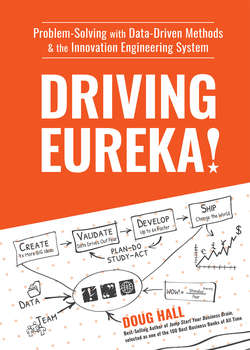Читать книгу Driving Eureka! - Doug Hall - Страница 18
На сайте Литреса книга снята с продажи.
The Mission of the Innovation Engineering Movement
ОглавлениеThe Innovation Engineering movement is a global community of innovation pioneers dedicated to system-driven innovation. Our mission is . . .
To change the world through systems that enable innovation by everyone, everywhere, every day, resulting in increased speed (up to 6x) and decreased risk (up to 80%).
Systems that Enable Innovation by everyone, everywhere, every day is the core of our mission. It’s also the right thing to do.
William Hopper, coauthor of The Puritan Gift, explained to me that enabling employees was the key to the Japanese Miracle: “In 1961 when Sumitomo Electric Industries won the Deming Prize, they did it in a totally different way. Before their victory the winner’s quality efforts were driven by experts. Sumitomo enabled all of the workers to be a part of the process of quality.”
The Deming prize committee in 1961 wrote of the win by Sumitomo:
One of the most important differences between Sumitomo Electric and other companies which have been awarded the Deming Prize is that in Sumitomo people from the top down to foremen worked together. This was an important difference from what happened in previous winning companies and may have contributed much to success.
A newspaper story in Japan on Sumitomo’s success told how they enabled frontline employees:
Foremen were trained to prepare control charts and became fully able to use them themselves. They then changed working methods so that younger workers could make products at a high yield. Before this quality-control method was introduced, only some highly trained technicians, with special skill and experience, could make products at a high yield. Afterwards, foremen were able to change the production method so that high yield was attained.
Sumitomo spent several million yen to introduce the new quality-control procedures, but the profit from them was in the hundreds of millions. The experience of Sumitomo is that if all employees cooperate to improve the method of manufacturing the product, a very high standard can be achieved.
—shared by Kenneth Hopper
As Japanese companies enabled frontline employees, industry gains from Deming’s teachings grew exponentially. Kenneth Hopper created the graph of productivity gains (shown on the following page) for an article he wrote in 1979. Note the dramatic growth in Japan starting in 1961 with the win of the Deming Prize by Sumitomo.
Innovation Engineering is dedicated to the same kind of shift—from innovation being the job of a small group of “gurus” to enabling innovation by everyone, everywhere, every day. The result is a transformation in innovation results.
Increased Innovation Speed: Increased Speed is important if we are to take advantage of the opportunities created by today’s digital and global economy. The good news is that order-of-magnitude increases in speed are possible. Digital tools and modern work systems make it possible to create, validate, manufacture, and make real new products, services, and internal ways of working faster than ever before.
Decreased Innovation Risk: Decreased Risk is important, given the epidemic of innovation failure that exists around the world. Research finds that just 5% to 15% of innovations are successful at large companies. Most business leaders would have greater odds of success if they went to a Las Vegas casino and gambled their innovation investment on one big bet. A slot machine would give them 32% odds of winning, blackjack 45%, and roulette 47%.
It’s easy to realize increased speed by accelerating projects without regards to risks. Similarly, it’s easy to reduce risk by slowing down all innovations and subjecting them to never-ending analysis.
What’s needed is the combination of Increased Speed and Decreased Risk. This can only be accomplished by changing the system of how we think, lead, and work.
